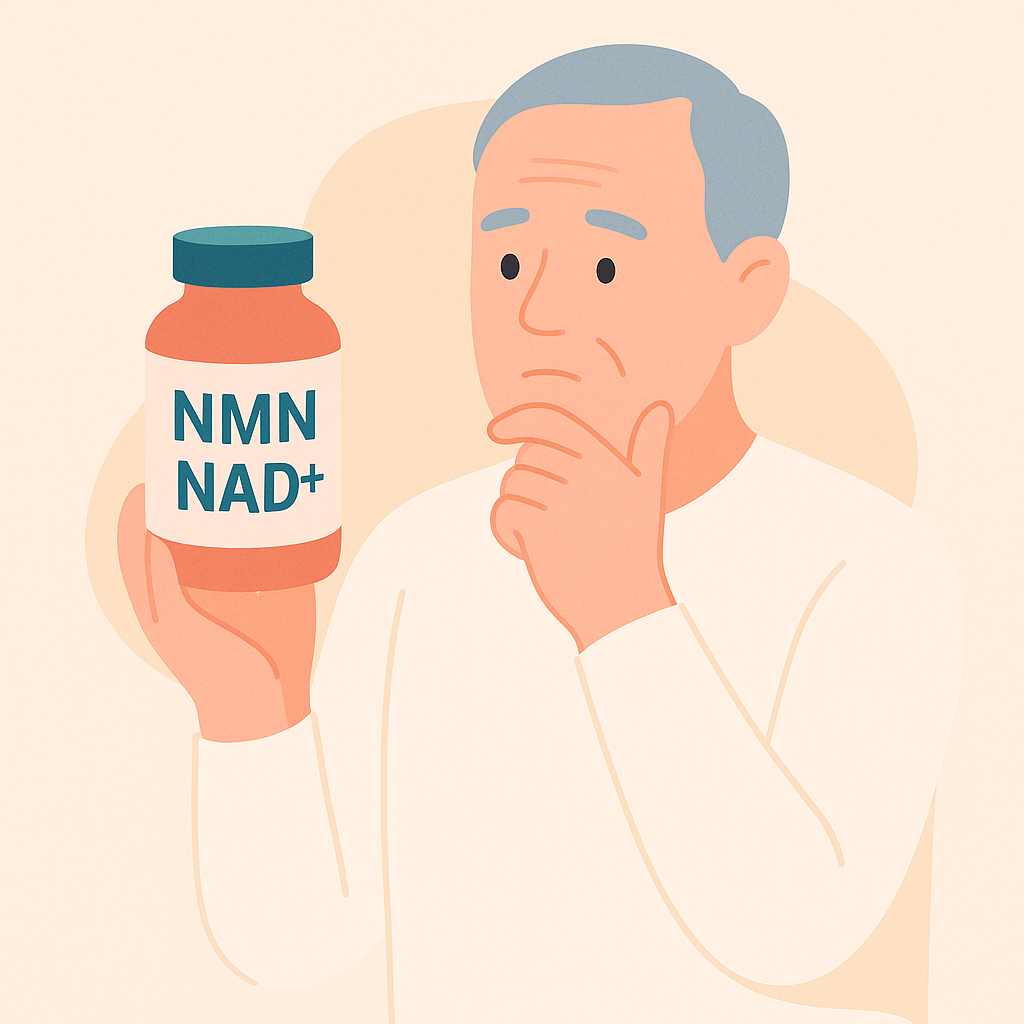
Over the past three decades, the nicotinamide adenine dinucleotide (NAD⁺) system has evolved from an obscure biochemical substrate of dehydrogenase reactions to a central axis in the study of aging, neurodegeneration, and cellular resilience. What began as a metabolic curiosity in the early vitamin B3 literature has become a framework through which mitochondrial dysfunction, DNA repair failure, and neuronal loss are now understood as facets of a shared energetic decline. The clinical translation of this insight—particularly through supplementation with NAD⁺ precursors such as nicotinamide riboside (NR) and nicotinamide mononucleotide (NMN)—has generated immense enthusiasm and equally measured skepticism. The trajectory of this research, from early mechanistic discoveries to the first human studies, reflects both the allure and the limitations of metabolic restoration as a therapeutic paradigm for the aging brain.
Origins and Early Exploration
Interest in NAD⁺ modulation as a therapeutic strategy emerged gradually through the 1990s. Early experiments with reduced NADH in patients with Alzheimer’s disease hinted at mild cognitive benefit, though the studies were small, uncontrolled, and mechanistically naïve. At that time, NAD⁺ was viewed purely as a redox cofactor—its link to neuronal survival not yet established. The conceptual shift began with the discovery of the Wallerian degeneration slow (Wld^S) mutation in mice, reported through the 1990s and early 2000s, which conferred remarkable axonal protection following injury. The protective transgene encoded a fusion protein that included nicotinamide mononucleotide adenylyltransferase-1 (NMNAT1), the enzyme converting NMN to NAD⁺. This single genetic observation reframed NAD⁺ metabolism as an active determinant of axonal longevity rather than a passive correlate of energy status.
By the mid-2000s, parallel work in yeast and mammalian systems had illuminated the role of NAD⁺ in regulating sirtuins—enzymes coupling metabolic state to genomic and mitochondrial function. SIRT1, SIRT3, and SIRT6 linked NAD⁺ levels to DNA repair, oxidative metabolism, and cellular stress responses. The idea that age-related decline in NAD⁺ might contribute causally to cellular senescence and neurodegeneration took hold. These early mechanistic discoveries transformed a coenzyme into a signaling currency for survival.
The Expansion into Brain Aging
Between 2010 and 2016, a wave of preclinical studies placed NAD⁺ at the center of brain aging research. Fang and colleagues demonstrated that restoring NAD⁺ in aged mice with NR improved mitochondrial function, synaptic plasticity, and cognitive performance, extending lifespan modestly. Around the same period, Scheibye-Knudsen, Imai, and others showed that NAD⁺ depletion in neurons activates a pseudohypoxic state, disrupting nuclear-mitochondrial communication and promoting DNA damage. The field began to converge on the hypothesis that NAD⁺ decline is not merely an epiphenomenon of oxidative stress but a driver of age-associated neurodegeneration.
Animal models of Alzheimer’s and Parkinson’s disease soon provided proof-of-concept. In transgenic APP/PS1 mice, NR or NMN supplementation reduced tau pathology, dampened neuroinflammation, and restored synaptic protein expression. In models of dopaminergic injury, NMN preserved mitochondrial integrity and attenuated motor deficits. Across systems, the rescue phenotype appeared strikingly consistent: metabolic rejuvenation, reduced inflammation, and improved function. Yet the diversity of models—acute toxin exposure, transgenic overexpression, and artificial aging—masked a deeper translational uncertainty: whether these interventions were correcting a cause of degeneration or merely buffering downstream metabolic failure.
Mechanistic Architecture
NAD⁺’s relevance to neurodegeneration lies in its dual identity as a substrate and a signal. It is consumed by enzymes that execute essential repair and survival programs—sirtuins, PARPs, CD38, and SARM1—each drawing from the same pool and thereby coupling cellular metabolism to fate decisions. In neurons, chronic DNA damage activates PARP1, depleting NAD⁺ and precipitating a form of energy-failure cell death termed parthanatos. In parallel, the immune NADase CD38, upregulated with age and inflammation, accelerates NAD⁺ turnover in astrocytes and microglia, amplifying neuroinflammatory tone. The SARM1 pathway adds another layer: a self-destruct mechanism in axons that senses the ratio of NMN to NAD⁺, triggering rapid NAD⁺ hydrolysis and axonal fragmentation when that balance tips unfavorably.
These intersecting pathways underscore both the promise and the peril of NAD⁺ restoration. Replenishing NAD⁺ can suppress PARP-mediated cell death, re-energize mitochondria through SIRT3 activation, and normalize inflammatory signaling via SIRT1. But indiscriminate supplementation with precursors may also perturb the NMN:NAD⁺ ratio, theoretically risking SARM1 activation or unregulated PARP activity. This delicate equilibrium makes the translation of preclinical enthusiasm into human application a matter of careful dose and context rather than brute force.
Translation and the First Human Trials
The first systematic human data emerged between 2016 and 2019. Dollerup and colleagues demonstrated that oral NR at 100–1000 mg/day for eight weeks dose-dependently increased whole-blood NAD⁺ levels in overweight men by up to 139 %, but produced no significant metabolic or cognitive improvements. Concurrent studies in Japan established the short-term safety of oral NMN up to 1250 mg/day, again showing robust NAD⁺ elevation without clinical change. These early investigations confirmed target engagement but also exposed a critical translational gap: the uncertain relationship between systemic NAD⁺ repletion and neuronal NAD⁺ restoration.
In 2022, the NADPARK study in early Parkinson’s disease provided the first imaging evidence that oral NR (1000 mg/day for 30 days) could raise cerebral NAD⁺ by approximately 17 % as measured by ^31P-MRS. The study also noted a modest, exploratory improvement in motor scores, insufficient for efficacy claims but sufficient to warrant further exploration. A subsequent dose-escalation trial up to 3000 mg/day confirmed safety but also revealed a mild rise in homocysteine—likely reflecting increased methylation demand for nicotinamide clearance. The implications of this biochemical shift for long-term use remain unresolved.
Thus far, no controlled human trial has demonstrated that NAD⁺ precursor therapy slows the clinical progression of Alzheimer’s or Parkinson’s disease. The collective data show that these agents are biologically active, safe in the short term, and capable of raising NAD⁺ levels in both blood and, modestly, brain—but they have yet to produce meaningful cognitive or functional outcomes. The field now stands where many neuroprotective strategies have faltered: at the threshold between mechanistic plausibility and clinical proof.
Safety, Metabolic Complexity, and Emerging Concerns
In the enthusiasm surrounding NAD⁺ “rejuvenation,” safety considerations demand equal attention. Chronic modulation of such a central metabolic axis carries theoretical risks. NAD⁺ fuels DNA repair and supports proliferative metabolism—both of which cancer cells exploit. Although no human data currently link NR or NMN supplementation to increased malignancy risk, recent murine studies in cancer-prone models suggest that NAD⁺ elevation can potentiate tumor growth by sustaining the inflammatory milieu of senescent cells. The duality is clear: the same metabolic resilience that protects neurons may also shield incipient cancer cells.
Metabolic side effects may be more subtle but no less relevant. Excess nicotinamide requires methylation for clearance, consuming S-adenosylmethionine and potentially raising homocysteine—a risk factor for vascular and cognitive decline. Elevated homocysteine observed in high-dose NR studies, though modest, underscores the need for monitoring methyl donor status in long-term use. Similarly, chronic NAD⁺ elevation could provoke compensatory upregulation of CD38, negating benefits over time or altering immune tone. In short, a system this central to cellular metabolism is unlikely to tolerate indefinite manipulation without adaptation.
Regulatory and Ethical Landscape
The regulatory status of NAD⁺ precursors has been as dynamic as the science itself. In 2022, the U.S. Food and Drug Administration ruled that β-NMN, under investigation as a pharmaceutical, could not be sold as a dietary supplement—a decision effectively reversed in 2025 after industry challenge. This oscillation highlights a broader uncertainty: NAD⁺ boosters straddle the line between vitamin and drug, marketed for anti-aging while being tested for disease modification. The clinical community thus faces an ethical tension: patients can access compounds with plausible mechanistic benefits long before rigorous efficacy data exist. Unsupervised self-administration at supra-physiologic doses risks both personal harm and the erosion of public trust in legitimate translational science.
Conceptual Integration
Viewed across the decades, NAD⁺ research reflects a recurring theme in neurodegenerative medicine: the attempt to reverse a global metabolic deficit through systemic intervention. It shares intellectual lineage with antioxidant therapy, mitochondrial cofactors, and metabolic enhancers that once promised rejuvenation but delivered only transient benefit. Yet NAD⁺ differs in one respect—it sits upstream of multiple survival networks, influencing energy metabolism, repair, and signaling simultaneously. The question is not whether NAD⁺ matters—it clearly does—but whether exogenous restoration can re-establish the complex spatial and temporal gradients that define cellular homeostasis.
The most plausible scenario is that NAD⁺ augmentation functions as a supportive metabolic scaffold rather than a singular disease-modifying therapy. It may enhance neuronal resilience, complementing interventions that directly target protein aggregation, vascular dysfunction, or inflammation. The challenge is defining when and in whom such metabolic support is meaningful—early in disease, when cells retain regenerative potential, or later, when irreversible pathology dominates.
Future Directions
For the field to mature, several priorities are clear. First, robust biomarkers of brain NAD⁺ metabolism must be developed—whether through ^31P-MRS, cerebrospinal fluid metabolites, or PET tracers—to confirm central target engagement. Second, clinical trials must extend beyond weeks to years, focusing on patients with early Alzheimer’s or Parkinson’s disease, where the window for metabolic intervention remains open. Third, safety surveillance must extend to carcinogenic potential, methylation status, and immune modulation, areas not captured in short-term studies. Finally, integration with lifestyle and pharmacologic strategies—exercise, caloric modulation, anti-amyloid therapy—should be explored, as NAD⁺ augmentation may be most effective within a multimodal framework rather than as a stand-alone intervention.
Conclusion
The story of NAD⁺ in neurodegeneration is a story of both aspiration and restraint. It embodies the modern instinct to repair aging biology by replenishing its molecular currency, and the parallel recognition that biology seldom yields to single-axis correction. The scientific arc—from the Wld^S mouse to current clinical trials—has illuminated the extraordinary interconnectedness of energy metabolism, inflammation, and neuronal survival. Whether that insight can be harnessed for true neuroprotection remains an open question.
For now, NAD⁺ precursors stand as promising metabolic adjuncts, emblematic of a broader shift toward systems-level restoration in neurology. Their ultimate value will depend not only on the magnitude of their effect but on our capacity to deploy them judiciously—anchored in evidence, aware of limitations, and integrated within the evolving architecture of precision brain-health therapeutics.

